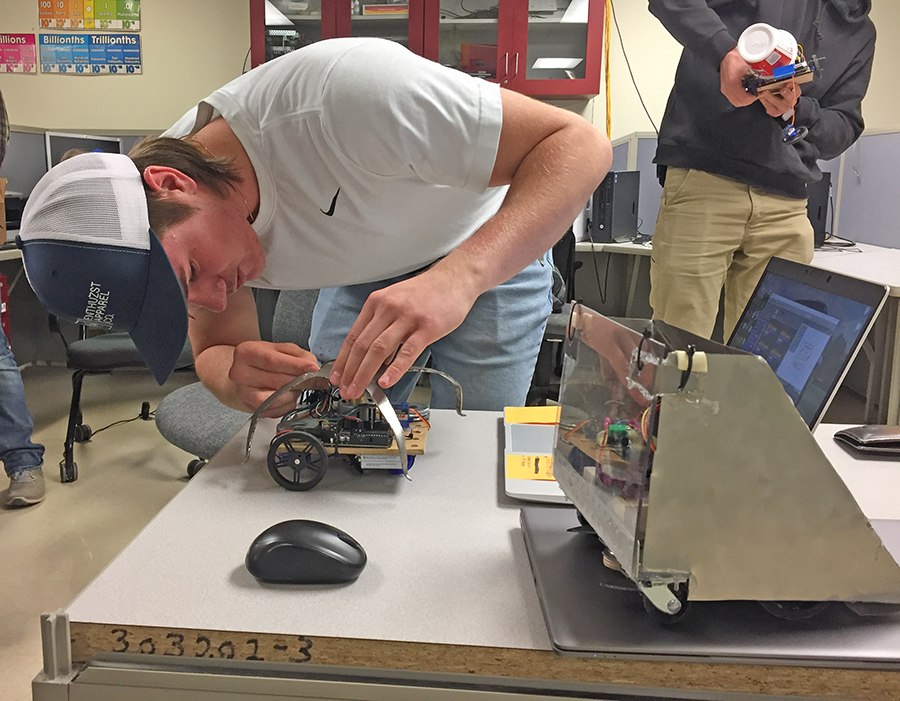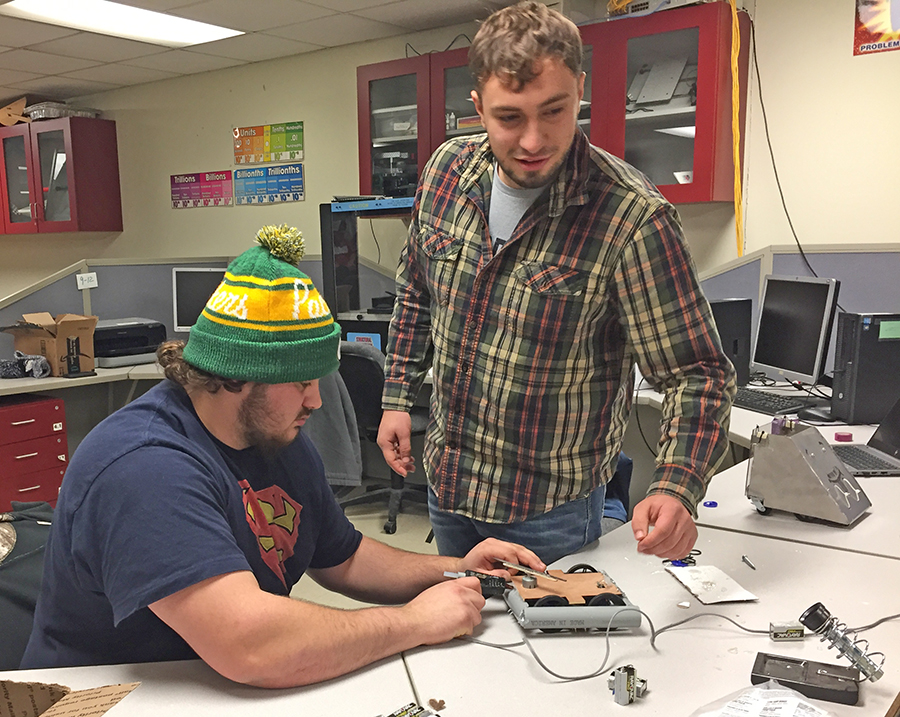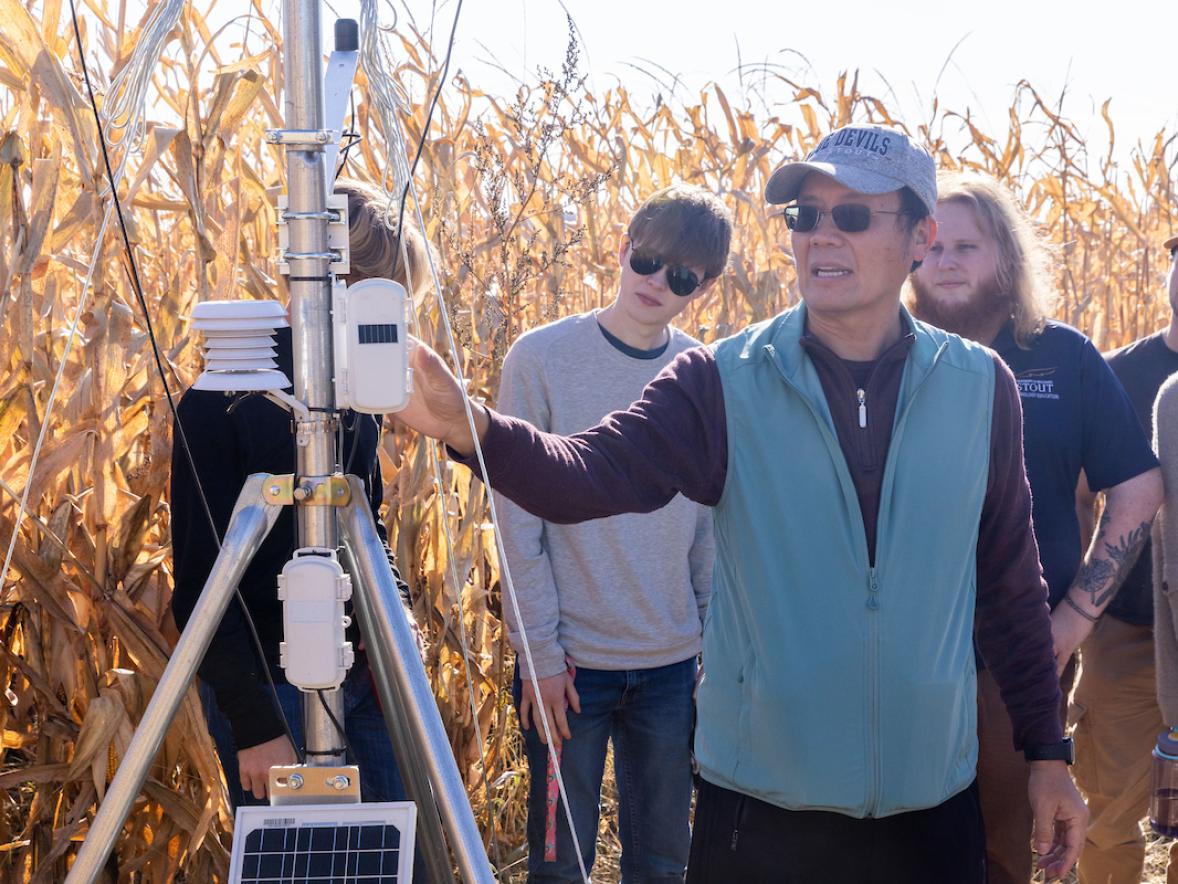Simple, strong and speedy could well have been the mantra of one robot created by University of Wisconsin-Stout students as their bot, named Scorpion, survived to take home bragging rights at a friendly competition.
Students in Kevin Dietsche’s Mechatronics 371 built and programmed sumo bots and then competed against each other in a 3-foot diameter circle. Bots that became disabled or were pushed out of the circle lost. The bots had to weigh less than three pounds.
It was a fierce competition as wheels were lopped off bots by spinning blades and as the machines battled each other.

Technology education majors Eli School, a senior from Suring, and Dexter Shipley, a junior from Lake Mills, created Scorpion using plastic PVC piping as bumpers, keeping the bot low to the ground and with four wheels, each with its own motor.
“The idea is PVC pipe is light, yet strong,” Shipley said, pointing out one nick their robot had after multiple battles. “Each wheel having independent drive gave us the torque we needed.”
If one wheel was damaged, the bot could keep its other wheels moving and continue to fight.
They also had a file tool they found in the garbage that spun to help attack opponents.
“We figured the file was hard, and we figured if we could get it spinning fast enough it would rip into our opponents,” Shipley said.
Similar to television shows such as “Battlebots” or “Robot Wars,” the bots were required to have an offensive or defensive weapon of some kind. Unlike TV counterparts, no water, liquid, chemical, electrical compressed gas, untethered projectiles or other potentially dangerous weapons were allowed.
Bragging rights for Scorpion were even sweeter this year when Dietsche entered a bot named the Minion, complete with goggles and two metal hooks as weapons. “It was too much fun not to make my own bot,” Dietsche said. “I wanted to get in on the competition and the fun. The students wanted to take me down.”
Dietsche said he learned the importance of making sure everything is secure on his robot. “I think I lost all four tires at one point,” he said.
This is the third year the class has done the sumo bot competition, said Dietsche, a lecturer in the engineering and technology department.
“What I like about it is it’s an applied project,” he said. “They are learning about electrical components, wiring, programming. They have to be creative. Many of them are going to be high school or middle school teachers eventually. This is a project they can take and do in their classrooms. It’s real for them.”
Students also use other labs on campus to build the bots, learning from other students and learning how to collaborate, Dietsche said.
School said he loved how the project encouraged imagination. “Whatever we wanted, we could build it,” he said.

During the competitions, students encouraged each other and laughed as their bots lost and, in many cases, lost parts. They would talk about improvements they could make and shared tools and batteries as they quickly helped each other rebuild their bots.
Meghan Cops, a senior technology education major from Brillion who plans to become a teacher, was part of a team that created a bot using a cottage cheese container as armor.
“I love the process of building,” Cops said. “I like the electrical components. I like the fact we had two weeks to work and build on it and figure it out. It takes problem-solving. It’s something I would want to bring to my classroom.”
Kyle Olson, a junior technology education major from Frederic, was part of a team that built the robot named Jellyfish, which had a spinning, bent blade and was shaped like its namesake.
“Honesty, I view the blade more as a defensive tactic rather than offensive,” he said. “It wraps around to protect the components, but it was a good weapon too.”
However, Olson said he wished he would have used the same feature as the Scorpion team. “I wish I had done four motors,” he noted. “Scorpion was able to keep moving and push its opponents.”
UW-Stout offers a Bachelor of Science in technology education and one in engineering technology.
###
Photos
Kyle Olson works on repairing his bot the Jellyfish.
Students Dexter Shipley, at left, and Eli School repair their bot the Scorpion, which went on to win the Mechatronics 371 class competition. PVC pipe as bumpers made the bot strong and light.





